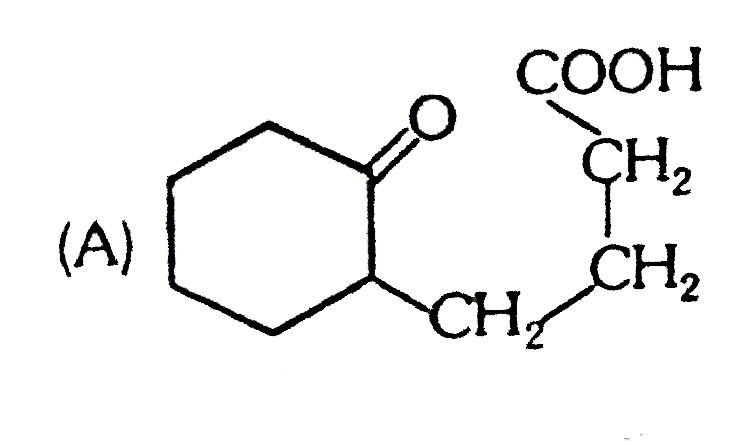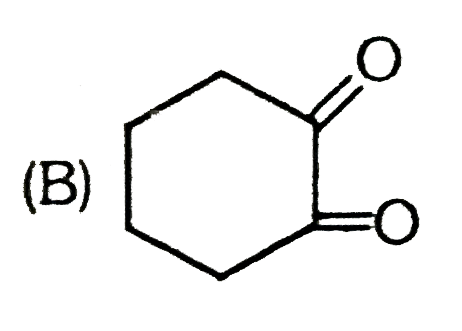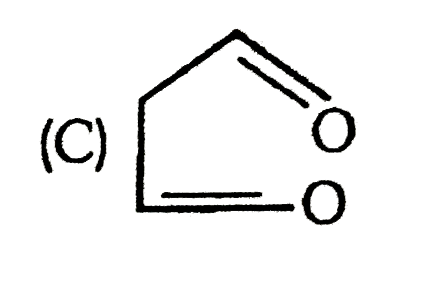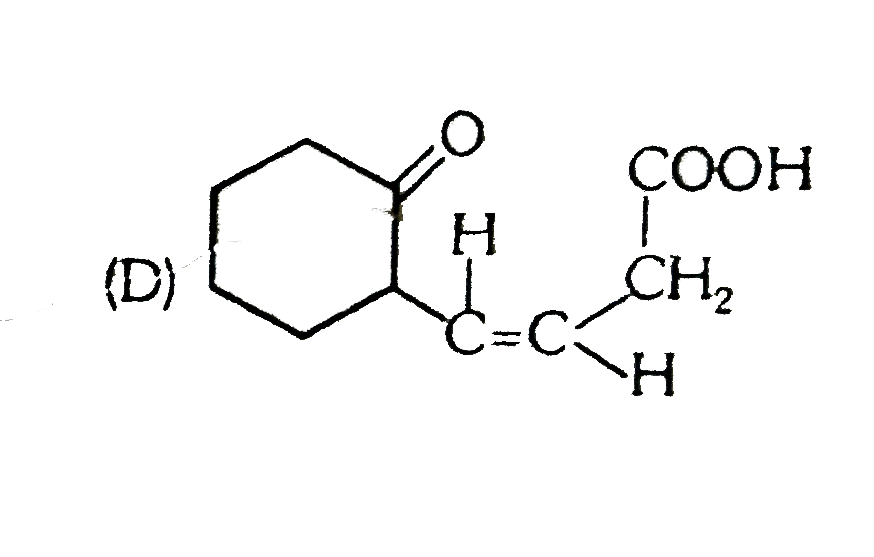An organic compound A has molecular formula C10H17Br and it is non-resolvable. A does not decolourize brown colour of bromine water solution. A on treatement with (CH3)2COK/(CH3)3COH yields B as majot product. B on treatment with H2/Pt yields (C10H16) which on treatment with CI2/hv yields three monochloro derivative. Also B on boiling with acidic permanganate solution yields C(C10H16O3)C. on heating with sodalime yields D(C9H16O).D on reducing with LiAIH4 followed yields C(C10H16O3).C on heating with sodalime yields D(C9H16O).D on reducing with LiAIH4 followed by heating product with concentrated H2SO4 yields E(C9H16) as major product. E on treatment with ozone followed by work-up with Zn−H2O yields 6-Ketononanal.
Compound C is:




The correct Answer is:A
To solve the problem step by step, we will analyze the information provided in the question and derive the structure of the compounds involved.
Step 1: Determine the structure of compound A
Given the molecular formula of compound A is C10H17Br, we can calculate the degree of unsaturation using the formula:
Degree of Unsaturation=2n+2−(h+x)2
Where:
- n = number of carbon atoms = 10
- h = number of hydrogen atoms = 17
- x = number of halogens = 1 (Br)
Substituting the values:
Degree of Unsaturation=2(10)+2−(17+1)2=20+2−182=42=2
This indicates that compound A has 2 degrees of unsaturation, which could be due to two rings or one ring and one double bond. Since A does not decolorize bromine water, it indicates that there are no double bonds present, confirming that A must contain two rings.
Step 2: Structure of compound A
Since A is non-resolvable (optically inactive), it cannot have a chiral center. Therefore, the bromine atom must be attached in such a way that it does not create chirality. A suitable structure for A would be a bicyclic compound with the bromine attached to a position that does not create a chiral center.
Step 3: Reaction of A with (CH3)2COK
When compound A reacts with the bulky base (CH3)2COK in the presence of (CH3)3COH, an elimination reaction occurs, leading to the formation of compound B. The bulky base promotes an E1 elimination, resulting in the formation of an alkene.
Step 4: Structure of compound B
The alkene formed (compound B) will have the formula C10H16. The structure will be a double bond between two carbon atoms in the bicyclic framework of A.
Step 5: Reduction of B with H2/Pt
When compound B is treated with hydrogen in the presence of platinum, it undergoes hydrogenation to yield a saturated compound, which retains the formula C10H16.
Step 6: Chlorination of B
Upon treatment with Cl2 in the presence of light, three monochloro derivatives are formed. This indicates that there are three distinct positions available for chlorination on the alkene.
Step 7: Oxidation of B with acidic permanganate
When B is boiled with acidic permanganate, it yields compound C with the formula C10H16O3. This suggests that the oxidation introduces hydroxyl groups and possibly a carboxylic acid.
Step 8: Heating with sodalime to yield D
Heating compound C with sodalime results in the formation of compound D with the formula C9H16O. This indicates a decarboxylation reaction.
Step 9: Reduction of D with LiAlH4
The reduction of D with lithium aluminum hydride (LiAlH4) will yield a compound that retains the carbon count but may change the functional groups.
Step 10: Final reactions and identification of compound C
After further treatment with concentrated H2SO4 and ozonolysis, compound E is formed, which leads to the identification of compound C as a ketone.
Summary
The compound C is determined to be a ketone with the molecular formula C10H16O3.
Given the molecular formula of compound A is C10H17Br, we can calculate the degree of unsaturation using the formula:
- n = number of carbon atoms = 10
- h = number of hydrogen atoms = 17
- x = number of halogens = 1 (Br)
Since A is non-resolvable (optically inactive), it cannot have a chiral center. Therefore, the bromine atom must be attached in such a way that it does not create chirality. A suitable structure for A would be a bicyclic compound with the bromine attached to a position that does not create a chiral center.
When compound A reacts with the bulky base (CH3)2COK in the presence of (CH3)3COH, an elimination reaction occurs, leading to the formation of compound B. The bulky base promotes an E1 elimination, resulting in the formation of an alkene.
The alkene formed (compound B) will have the formula C10H16. The structure will be a double bond between two carbon atoms in the bicyclic framework of A.
When compound B is treated with hydrogen in the presence of platinum, it undergoes hydrogenation to yield a saturated compound, which retains the formula C10H16.
Upon treatment with Cl2 in the presence of light, three monochloro derivatives are formed. This indicates that there are three distinct positions available for chlorination on the alkene.
When B is boiled with acidic permanganate, it yields compound C with the formula C10H16O3. This suggests that the oxidation introduces hydroxyl groups and possibly a carboxylic acid.
Heating compound C with sodalime results in the formation of compound D with the formula C9H16O. This indicates a decarboxylation reaction.
The reduction of D with lithium aluminum hydride (LiAlH4) will yield a compound that retains the carbon count but may change the functional groups.
After further treatment with concentrated H2SO4 and ozonolysis, compound E is formed, which leads to the identification of compound C as a ketone.
The compound C is determined to be a ketone with the molecular formula C10H16O3.
Topper's Solved these Questions
- ALKYL AND ARYL HALIDEBOOK - ALLENCHAPTER - ALKYL AND ARYL HALIDEEXERCISE - EXERCISE-02
1 Videos
- ALKYL AND ARYL HALIDEBOOK - ALLENCHAPTER - ALKYL AND ARYL HALIDEEXERCISE - EXERCISE-04 [A]
1 Videos
- ALKYL AND ARYL HALIDEBOOK - ALLENCHAPTER - ALKYL AND ARYL HALIDEEXERCISE - EXERCISE-01
1 Videos
- ALKENE, ALKANE & ALKYNE BOOK - ALLENCHAPTER - ALKENE, ALKANE & ALKYNE EXERCISE - EXCERSISE-3
28 Videos
- Atomic StructureBOOK - ALLENCHAPTER - Atomic StructureEXERCISE - All Questions
62 Videos
Similar Questions
Knowledge Check
Which alkyne yields butanoic acid (CH3CH2CH2CO2H) as the only organic product on treatment with ozone followed by the hydrolysis ?
A1-ButyneB4-OctyneC1-PentyneD2-HexyneTreatment of a 2∘ OH with CrO3/H2SO4 yields an/a :
AaldehydeBcarboxylic acidCesterDketone
An alkyl bromide A has molecular formula C8H17Br and four different structures can be drawn for it, all optically active. A on refluxing with ethanolic KOH solution yields only one elirnination product B(C8H16) which it still enantiomeric. B on treatment with H2/Pt yields C(C8H18) which does not rotate the plane polarized light, B on ozonolysis followed by work-up with H2O2 yields D(C7H14O) as one product which it still resolvable. Deduce structures of A to D.
View SolutionAn organic compound (X) has molecular formula C7H6O2
and it does not effervesces with NaHCO3. X on treatment with
excess of HBr(aq) gives Y(C6H6O2) and CH2Br2. Y forms a
violet coloured solution with FeCl3. If X treated with Br2Fe,
how many different monobromination product would result?
View SolutionA hydrocarbon A(C10H12) has no chiral carbon. A gives a white precipitate with ammonical solution of silver nitrate. A on treatment with H2/pt gives B(C10H20). A on ozonolysis gives C(C8H12O4) as one product which on heating with soda lime gives D(C6H12). D on monochlorination with Cl2/hv gives C6H11Cl as sole isomer. Identify A to D.
View SolutionAmong the isomeric alkanes formula C5H12, identify the one that on photochemical chlorination yields only monochloro derivative.
View SolutionAn optically activ compound (A) has the molecular formula C6H10. The compound gives a ppt. When treated with Ag(NH3)2OH. On catalytic hydrogenation, A yields B(C6H14) which is only optically inactive identify the total number of αH in product formed by treatment of A with O3/H2O2 then LAH and then H⊕/Δ
View SolutionAn organic compound A’ with molecular formula C7H7NO reacts with Br2/aqKOH to give compound B’, which upon reaction with NaNO2&HCl at O∘C gives C’. Compound C’ on heating with CH3CH2OH gives a hydrocarbon D’. Compound B’ on further reaction with Br2 water gives white precipitate of compound E’. Identify the compound A, B, C, D&E, also justify your answer by giving relevant chemical equations.
View Solution
